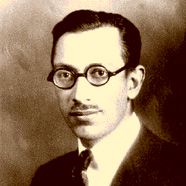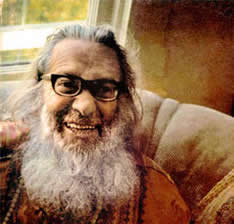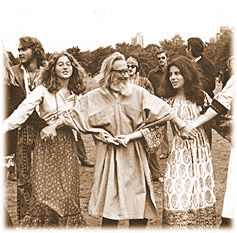Murshid Samuel Lewis 1896-1971
Mystic, Sufi Master, Zen Teacher, Peace Activist, Horticulturist, Scientist, Madzub: Samuel L. Lewis has been called these things and more. The originator of the Dances of Universal Peace was a spiritual renaissance man whose life and teachings were a testimony to truth, originality and embodied spirituality. Though rejected by polite society and even his own family because of his spiritual leanings, Samuel Lewis remained true to the penetrating spiritual vision of human liberation at the core of his being. His life, often difficult, bore much fruit for his students and for the world.
 Born October 18, 1896 in San
Francisco, California USA to Jacob Lewis, a vice-president of
the Levi Strauss Company, and the former Harriet Rothschild of
the international banking family, young Samuel was a
precocious and brilliant child who from an early age showed
strong interest in mysticism, past lives and psychic
phenomena. Despite his family's efforts to encourage him
toward a life of material pursuits and business success, he
was invariably attracted to spirituality. Though he graduated
with honors from San Francisco's top high school, his wealthy
family refused to send him to college because his values were
so different from theirs.
Born October 18, 1896 in San
Francisco, California USA to Jacob Lewis, a vice-president of
the Levi Strauss Company, and the former Harriet Rothschild of
the international banking family, young Samuel was a
precocious and brilliant child who from an early age showed
strong interest in mysticism, past lives and psychic
phenomena. Despite his family's efforts to encourage him
toward a life of material pursuits and business success, he
was invariably attracted to spirituality. Though he graduated
with honors from San Francisco's top high school, his wealthy
family refused to send him to college because his values were
so different from theirs.
Samuel encountered the teachings of the Theosophical Society
in 1915 at the World's Fair in San Francisco. The universality
of Theosophy, of seeing the religions of the world as
different rays of one truth, resonated deeply in him, and
Samuel continued to study world religions voraciously. In 1919
he met and began what would become a long association with
Rabia Martin, Hazrat Inayat Khan's representative in the
United States. Around that time he also began formal Zen
training with Nyogen Sensaki, a Rinsai monk and one of the
foremost early teachers of Zen in the United States. From then
on Samuel's spirituality took a decidedly deeper turn. In 1923
he had the first of several audiences with Sufi Inayat Khan and
received initiation from him. Later in life Samuel would
express his conviction that he received regular psychic
messages from the late Sufi master.
During the depression years Samuel lived a simple life as a
gardener while becoming involved with social issues, including
world peace. He lived at the Sufi Khankah called "Kaaba Allah"
in Fairfax, California and began writing essays on spiritual
themes. During World War II he worked as an historical
consultant and secretary for Army Intelligence.
As early as 1940 he first noted the power of spiritual dance
to awaken human beings to their true nature. He wrote:
What does dance do for us? First and foremost, it inculcates the sense of rhythm and enhances our response to rhythm. This is really a response to life. It makes us more living, which is to say, more spiritual. It brings out beauty of form and movement, and envelops our personalities in the enjoyment of them. It takes us beyond ourselves, bringing an initial taste of the state of non-being, which is really a balm for the soul.1
 In 1956 he traveled
to Asia, which exposed him to spiritual practices and realized
sages in the East. On his travels he was widely accepted as an
awakened being by the spiritual communities he visited. This
cultural and spiritual stimulus furthered the development of
his ideas.
In 1956 he traveled
to Asia, which exposed him to spiritual practices and realized
sages in the East. On his travels he was widely accepted as an
awakened being by the spiritual communities he visited. This
cultural and spiritual stimulus furthered the development of
his ideas.
Samuel eventually was accepted as a "Zen-shi," or teacher of
Zen Buddhism. He also studied underSwami Papa Ramdas and was
recognized as a teacher of Bhakti yoga, of Christian mysticism
as one of the founders of the Holy Order of M.A.N.S., and of
the Hebrew Kaballah. He stated it was not his desire to
associate his peace work or his Dances with any particular
spiritual tradition or sect. Of this he said:
Divine truth does not belong to any organization. If I organize here, it will be made under the title of "Islamia Ruhaniat Society," that is, the complete teachings of spiritual sciences which lead to realization of peace. As I'm working with my colleagues in other faiths, this will demonstrate this. We're not going to be called "Sufis" to distinguish ourselves from somebody else.2
According to Murshid Wali Ali Meyer, his esoteric secretary in
the last years of his life, Murshid Samuel Lewis offered Sufi
teachings to the young people and hippies of the San Francisco
Bay Area in the
 |
|
Murshid Sam's early Dance notes
|
1960s because no one else was doing it. In the upsurge of interest in Eastern spirituality of that period, Zen, Hindu meditation and many other practices were available, but not Sufism. Murshid Sam would offer a full week’s program of dharma talks, Dance classes, Walks in astrological yoga and the Sufi gathas, and during the 1960s a growing group of disciples gathered around him at his home in Precita Park, San Francisco. Often feeding his students meals from his own table, he said that his peace plan for the world was to "Eat, Dance and Pray together".
The Dances of Universal Peace in many ways were the summation
of Murshid Sam's life experience and spiritual attainment.
Through Dance, spiritual Walks and practices he was attempting
to strengthen the latent aspects of his students’
personalities and awaken them to the fullness of truth. He
explained:
Now, I am not running a fun club, and I am not running a dramatic show. I believe we can learn through exaltation, through ecstasy, through joy and through love. At the same time we must also keep one eye open, so to speak, on our peace, if we want strength, because strength comes out of our inner peace. A lot of people go and speak against ecstasy and they don't know what it is. A lot of people speak for it and they don't know what it is. So I find love should produce a certain kind of ecstasy and ecstasy if it is real will produce a certain kind of love.3
The Dances of Universal Peace bear the lasting influence of
Murshid Sam's contact and spiritual apprenticeship with Hazrat
Inayat Khan, who first brought the message of universal Sufism
to the West in 1910, and Ruth St. Denis, a
feminist pioneer in the modern dance movement in America and
Europe. Of the latter he wrote:

My fairy godmother, so to speak, Ruth S. Denis, approved of all my plans, and before she left the world I had begun my “Dances of Universal Peace.” I started out with Dervish Dances, then Indian ones. Now I am ready to restore or start Christian mystical dances. These dances are dedicated to the Temple of Understanding in Washington D.C., which is endeavoring to take to heart the psalmist's words, “My house shall be a house for all peoples."4
From his rich life experiences Murshid Samuel Lewis envisioned
and created the Dances as a dynamic method to promote "Peace
through the Arts." From the early days and his original body
of about 50 dances, the collection has grown since his passing
in 1971 to more than 500 dances, which celebrate the sacred
heart of Hinduism, Buddhism, Zoroastrianism, Sikhism, Judaism,
Christianity, Islam, and the Aramaic, Native American, Native
Middle Eastern, Celtic, Native African, and Goddess
traditions. His work continues through the teachers of the Sufi Ruhaniat International,
the order which Murshid Sam founded, and through the Dances of
Universal Peace International Network.
1 Excerpt from Samuel Lewis’ paper Spiritual
Dancing, circa 1940. Full paper is available in the Resource
Library of this web site.
2Spiritual Dance and Walk, 1990 PeaceWorks
International Center for the Dances of Universal Peace, p. 12.
3 Transcription from the film Sunseed, by Frederick
Cohn 1973.
4 Letters of Samuel L. Lewis, July 28, 1970.
Links:
See extensive information about Murshid Samuel Lewis on the Sufi
Ruhaniat International website
Wikipedia:
Samuel L. Lewis
MurshidSam.org - Esoteric
papers, commentaries, diaries and 64 recorded talks of Murshid
Sam are available on this site.
Mansur Johnson's book Murshid: A Personal
Memoir of Life with American Sufi Samuel Lewis,
PeaceWorks Publications, Seattle, Washington 2006.
 English
English Español
Español Français
Français Deutsch
Deutsch Nederlands
Nederlands Português
Português Русский
Русский
